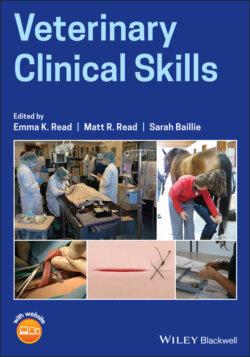Читать книгу Veterinary Clinical Skills - Группа авторов - Страница 18
Step 2: Determining and Prioritizing Content
ОглавлениеBefore a decision can be made regarding which clinical skills can, and should, be included in the curriculum, there must be a common understanding among the people involved in its implementation as to what constitutes a clinical skill in their context. For example, one study used a Delphi process and showed a marked variation between participants (British doctors involved in teaching) as to what this term meant, ranging from simple physical examination skills to include other diagnostic, communication, and practical skills (Michels et al., 2012). They concluded that acquiring clinical skills involved three components: learning how to perform certain movements (procedural knowledge), why one should do so (underlying basic and medical science knowledge or declarative knowledge), and what the findings might mean (clinical reasoning); and that these three components should be taken into account during instructional design.
Once a decision has been made as to what constitutes the range of clinical skills required for veterinary and/or veterinary nursing students to be taught in the program, the specific skills should be identified and prioritized. This may be easier said than done, as although clinical skill training is an integral part of all veterinary curricula, the specific skills that are required and how they are taught has been the subject of much debate (Malone, 2019). This is particularly the case when veterinary programs become overloaded as more and more content is added, requiring specific decisions to be made regarding the clinical skills content, as well as when and how they are taught (Malone, 2019).
Generation of a prioritized, Day‐One skills list will help focus both program and student efforts on core skills, with potential additional lists that may be taught to a smaller cohort of students for colleges or schools with a tracking curriculum. These lists could be adopted from those published in the literature, and potentially modified by local practitioner input to account for regional differences (Greenfield et al., 1997). Published skills lists for veterinary students exist for general Day‐One practice (Greenfield et al., 1997; Doucet and Vrins, 2009; Rush et al., 2011; Schull et al., 2011; Read and Hecker, 2013; Dilly et al., 2014; May, 2015; Kreisler et al., 2019; Malone, 2019), a variety of career paths, including those focused on small animals (Clark et al., 2002; Greenfield et al., 2004; Greenfield et al., 2005; O'Neil et al., 2014), horses (Hubbell et al., 2008; Christensen and Danielsen, 2016), and cattle (Morin et al., 2002a; Morin et al., 2002b; Miller et al., 2004; Luby et al., 2013), as well as lists focused on specific fields such as surgery (Johnson et al., 1993; Bowlt et al., 2011; Hill et al., 2012; Smeak et al., 2012; Schnabel et al., 2013; Carroll et al., 2016; Zeugschmidt et al., 2016; Cosford et al., 2019), dentistry (Thomson et al., 2019), or theriogenology (Root Kustritz et al., 2006). Additional resources may include those skills required by accrediting agencies (e.g. the AVMA COE's 9 clinical competencies), internal surveys of faculty, and Day‐One skills lists shared by other colleges (Morin et al., 2020). For veterinary nursing students, Day‐One competencies lists have been published by the Royal College of Veterinary Surgeons, the Veterinary Nursing Council of Australia, and the South African Veterinary Council (RCVS 2015; VNCA 2019; SAVC 2020).
Care must be taken to prioritize these lists, as they can quickly become exhaustive, and thereby both unattainable and confusing for the student. For example, an informal survey of eight US veterinary colleges in 2009 generated a list of over 900 different, individual clinical skills, of which approximately three quarters were considered core by college faculty, but only 105 were shared by half or more of the colleges (Lizette Hardie, personal communication). Consideration, therefore, should be given to those skills considered essential for a Day‐One veterinarian versus those that may be better learnt or mastered by a subset of students, or after graduation, for example in clinical practice or in continuing education programs (Malone, 2019; Duijn et al., 2020). This consideration should also take into account those skills that may be life‐saving if done correctly, and those that might be life‐endangering if done incorrectly (Malone, 2019). In this context, a short list of crucial skills could be valuable and could ensure we are “teaching to the common uncommonly well” (Henry J. Heinz), rather than providing exposure but not necessarily competence (Malone, 2019).
Finally, consideration should be given not only to the skills that should be included in this list, but also to the opportunities for students to master these skills. For example, the skills on a school's prioritized list of clinical skills may not be the set of skills they are exposed to in a high‐level referral teaching hospital. It is essential students are given time to learn and practice these skills in the curriculum, and that this is structured to prepare them for the next stage, for example progressing from learning basic skills to more complex procedures, or in readiness for the clinical year or work placements such as extra‐mural studies. Monitoring both students' confidence and competence in these skills would help ensure graduates are meeting the minimum standards expected.
